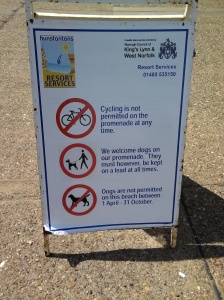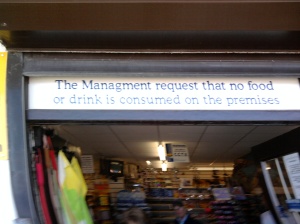Part 1 – Walking the Promenade
A trip to ‘Sunny Hunny’
By Tina Richardson
Late morning on Wednesday June 2nd 2010 I set off from Northgate in Hunstanton (named after the local red Carr Stone – ‘honeystone’), Norfolk to explore the promenade. However, unlike John Betjeman I was unable to take the train from King’s Lynn railway station directly to Hunstanton (Hunst’on, as it is to the ‘locals’), as the line was closed in 1969:
The title of this blog – “Out of nothing in the middle of nowhere.” – refers to the phrase that is often used to describe Hunstanton’s origins: it sprung from a rural landscape and was developed for the sole purpose of turning it into a seaside resort. Schizocartography refers to the methods I use to highlight dominant power structures, while attempting to provide alternative narratives (often subjective) in text, image and map form.
I journeyed down the prom from the north to the south end and back again. Being one of the sunny days of the recent boost of sun, and also half-term, the prom and beach were quite busy. Although, since my walk was psychogeographically-oriented my remarks, as you will see, concentrate on what is often not noticed on a casual viewing.
Donut Heaven (or the Disneyfication of the Seaside)
While the kiss-me-quick quality of the 60s seaside resort has diminished, it has become an almost hyper-real space that is highly oriented around consumerism. The proliferation of signs is positively Baudrillardian, it was difficult not to be interpellated by them and I had to make a conscious effort to notice other stimuli.
I was particularly drawn to the notices that were prohibiting particular actions and behaviours. Here is a sample of some of those on the prom itself. I especially like the one that says “This area is for pony rides only. No kites, chairs, balls, inflatables, etc” and then pretends to be a council notice by writing (in marker pen) KL & WNBC on the bottom which stands for King’s Lynn and West Norfolk Borough Council:
Nevertheless, the deckchair hiring companies seemed to challenge this draconian approach and, in fact, do the opposite by allowing you to help yourself to the deckchairs, prior to paying for them:
Utilities Boxes
There appear to be a number of power boxes, serving the nearby outlets, within easy access of the prom. There were far too many to photograph, (even though it would be an interesting project to do so).
I looked for utility boxes on google and found this stylish one made by a company in the US. It might be an interesting idea for Hunstanton to fund an art project for blending the utility boxes in with their respective backgrounds. This will simultaneously turn them into a (tourist) feature unique to the resort.
This image has been reproduced by the kind permission of American Gas Products Inc www.americangasproducts.com
Liminal Spaces
A couple of interesting (lost) spaces caught my attention. The image I have called “Welcome to My Garden” was located between one of the large plastic childrens’ slides on the prom and the themed crazy golf course. The other, “Discrete Concrete”, was a nook under the ramp of the Surfside Cafeteria.
The deep topographer Nick Papadimitriou is often attracted to these in-between spaces. So, too, is Patrick Keiller as can be seen in his Robinson series of films.
(go to 45 seconds into the film to see an example of a liminal space – a portakabin at Elephant and Castle, London)
Nick Papadimitriou’s site: (films by John Rogers)
Past and Present
At one of the car parks adjacent to the prom is this road sign which appears within the car parking space, against the wall that divides the car park from the prom:
Douglas Bader, the famous pilot who crashed while doing aerobatics and lost both his legs, must have some connection to Hunstanton outside of his relationship to Norfolk (where he served in the RAF). However, following a quick search I am unable to find what this is.
There is a tourist notice nearby (headed “Hunstanton Past and Present: The Promenade”) which says: “The seafront from the Green to the fairground was developed during the 1920s and 1930s on land reclaimed from the sea.”.
According to The Hunstanton Story: The First Fifty Years 1861-1911 by Mary Rhodes: the first section of the prom was not built until 1879. The second section “was erected later, roomy shelters with long wooden seats all round the walls and an ornamental balcony on the roof were added. Convenient slopes and steps at each end gave access to the beach. Another refinement about this time was the drinking fountain on the Green at the head of the pier – a generous gift presented by Jamesina Waller.”
Conclusion
Hunstanton, a place I visited as a child in the 60s, has become infinitely more interesting due to my psychgeographical drift along its prom. It has also hugely improved as an urban space and resort in comparison to the slump it appeared to be in in the early 1980s. My schizocartography will continue with the second part of this blog which covers the area behind the prom at the North end.
Bibliography:
Rhodes, Mary. Date Unknown. The Hunstanton Story: The First Fifty Years 1861-1911 (Warwick: Private Publication).
For information on my other work please go to: particulations























